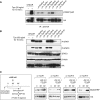Orientation-specific signalling by thrombopoietin receptor dimers
- PMID: 21892137
- PMCID: PMC3230373
- DOI: 10.1038/emboj.2011.315
Orientation-specific signalling by thrombopoietin receptor dimers
Abstract
Ligand binding to the thrombopoietin receptor is thought to stabilize an active receptor dimer that regulates megakaryocyte differentiation and platelet formation, as well as haematopoietic stem cell renewal. By fusing a dimeric coiled coil in all seven possible orientations to the thrombopoietin receptor transmembrane (TM)-cytoplasmic domains, we show that specific biological effects and in vivo phenotypes are imparted by distinct dimeric orientations, which can be visualized by cysteine mutagenesis and crosslinking. Using functional assays and computational searches, we identify one orientation that represents the inactive dimeric state and another similar to a physiologically activated receptor. Several other dimeric orientations are identified that induce proliferation and in vivo myeloproliferative and myelodysplastic disorders, indicating the receptor can signal from several dimeric interfaces. The set of dimeric thrombopoietin receptors with different TM orientations may offer new insights into the activation of distinct signalling pathways by a single receptor and suggests that subtle differences in cytokine receptor dimerization provide a new layer of signalling regulation that is relevant for disease.
Conflict of interest statement
The authors declare that they have no conflict of interest.
Figures







References
-
- Adams PD, Engelman DM, Brunger AT (1996) Improved prediction for the structure of the dimeric transmembrane domain of glycophorin A obtained through global searching. Proteins 26: 257–261 - PubMed
-
- Alexander WS, Roberts AW, Nicola NA, Li R, Metcalf D (1996b) Deficiencies in progenitor cells of multiple hematopoietic lineages and defective megakaryocytopoiesis in mice lacking the thrombopoietic receptor c-Mpl. Blood 87: 2162–2170 - PubMed
Publication types
MeSH terms
Substances
Grants and funding
LinkOut - more resources
Full Text Sources
Other Literature Sources
Molecular Biology Databases

